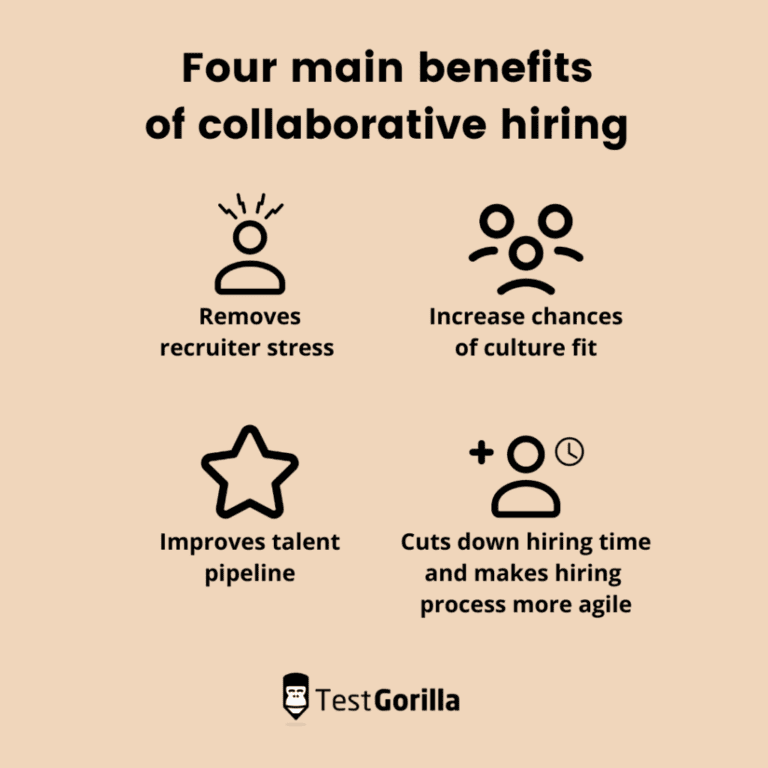A collaborative hiring process uses the expertise of the wider team to enhance an organization’s recruitment. When it works well, it is both an expression of a healthy team culture and a way to strengthen it even more.
This article makes a case for it and outlines how well-functioning teams can be involved in recruiting new members as part of a hybrid culture workspace.
Why has collaborative hiring grown in popularity?
How does your business currently recruit new members? Traditionally, it may have involved only a small group of people. That may have included the manager looking for a new team member and someone from HR. Or it may have all fallen to just one lonely recruitment manager.
They would have overseen the entire process, from preparation to appointment and onboarding. It’s a big job: attracting, screening, and selecting the most suitable applicants with the best fit for your business. Getting it right can propel your teams to new heights.
Does keeping recruitment as a tightly siloed process make sense when the stakes are so high? Numerous studies suggest that recruitment is not always successful. Take, for example, the finding that 25% of turnover happens in the first six months of employment.
With a collaborative hiring strategy, multiple points of view from across the business can feed into the process. That can lead to better-suited applicants and better decisions.

What is a collaborative hiring strategy?
A collaborative hiring strategy gets employees from across the business engaged in recruitment processes. Staff from all departments can be involved; the more, the better.
All stages of the recruitment process can be made collaborative: from writing the job descriptions, promoting the role, selecting from applicants, identifying interview questions, making the decision, all the way through to onboarding.
As we will see, at each stage, a collaborative approach can confer benefits, both for the company and the applicant. It strengthens your recruitment funnel, attracting good quality candidates and helping to optimize the process for all concerned.
Bringing new talent into the business need no longer be distanced from day-to-day business activity. New members do not just magically appear following a secretive, behind-doors process. It makes recruitment a shared concern and business priority for all.
One person (typically the hiring manager) will need to retain ownership of the process. But the entire team benefits from great appointments. So why not use their skills and commitment to get the best possible outcome?
How does it work?
Collaboration can support each stage of a recruitment journey.
Defining the role
One of the first steps is to write a great job description and candidate profile. These capture the criteria for the ideal candidate.
Who better to input than people already doing the job? And additionally, the people who work closely with the proposed role. Your teams know best what is needed: what experience and skills are essential and what qualities would make an ideal cultural fit.
A broader input can help determine what you emphasize. For example, while writing proposals may be a core part of the job, email business proposal template software may make compiling these straight-forwards. An analytical mind and a good grasp of data may be more critical.
By collecting a wide range of viewpoints across the organization, your advert will better match the reality of the post. That will help link you to the most suitable applicants. You are increasing your chances of finding a good fit: someone who will meld into the team for the long haul.
Existing employees will feel more valued and engaged if the process listens to their team’s needs and addresses these directly.
Marketing the role
Now to reach as many people who may fit the role as possible. There are various ways you can make this collaborative.
Firstly, you can encourage your employees to share the job advert with their networks. Indeed, perhaps they know someone who would be a great fit. An employee referral scheme can structure this (and give staff an extra incentive to help spread the word to excellent candidates).
Secondly, you can encourage your staff to be on the watch for talent. That may be at conferences or professional body meetings, for example. Employees are more likely to help if you value their input throughout the recruitment process.
Thirdly, staff can advocate for the business. That means acting as ambassadors to potential candidates. They can also create videos, blogs, social media postings, or personal profiles to build a more detailed picture of working for the company.
For example, maybe they could explain things like how customers can call remote employees via a virtual phone number regardless of where they’re working from. It is an opportunity to showcase what is great about working for your business.
That is all good for the business. Your team is engaged with the process, helping find the best people and strengthening your recruitment funnel. And it is also helpful for the applicants because they will have a fuller and more authentic sense of the role and workplace culture. It will help them determine if this is the best job for them, even before they apply.
Even if you are away, with a collaborative approach, your employees can help applicants with any queries they may have. Make sure you have phone forwarding services switched on so a colleague can help.
Short-listing
Once you have got your applicants, the next step is screening them and selecting some to interview. Once again, collaboration can add value to this stage.
If hiring involves only the same one or two people, unconscious feelings or assumptions may shape decisions. That can hold the business back. Highly talented applicants might get overlooked. And there is a risk of an overly homogenized, groupthink culture emerging.
In a collaborative approach, a wider pool of people can contribute their views about the applications. That can mitigate the risk of various biases. You are more likely to end up with a diverse short-list for interviewing, which could be healthy for your organization.
It is also an opportunity to sharpen your thinking about what you are looking for in a successful candidate. Unexpected skills may emerge from the applications. For example, maybe one applicant has a strong background in customer profiling, something that could benefit your business. The desired features can be discussed and evolve as the process unfolds.
Interviews
Employees can suggest questions for the interviews. They are likely to know the role best and so can suggest salient areas to explore. What skills are crucial but perhaps not so obvious? For example, maybe experience working with mass email will be significant to the business’s operations in the future.
What scenarios or tasks could explore whether applicants are well-suited? And what would the ideal answers to these include?
Peer interviews – where one or more of your existing team chat with the candidates – can also be valuable. They provide candidates with an authentic taste of the role and company. Candidates can ask more project-specific questions. For example, what are the company’s QA methods?
Your employees have a chance to get to know the applicants and sell your company to the best ones. And it sows seeds for a better onboarding experience.
Decision-making
You have received the applications and conducted the interviews and activities. Now, you have to choose.
Even at this final step, you can be collaborative. Collect views on the applicants. Who might be the best fit? Having gone to the effort of involving people earlier, you should get their thoughts now. Different opinions might emerge, emphasizing particular skills, experiences, or qualities.
That may make reaching a decision harder. But it is an opportunity to reflect on what your business needs most. Your obvious choice may not be the best fit for the team overall. It is a final opportunity to reach a holistic decision, free of unconscious bias.
Once decided, be sure to use feedback from colleagues in your approach to the selected candidate. If your team loved them, explain why. That can help them feel welcomed immediately – and is a great way to encourage them to accept the offer!
Onboarding
You may have found the perfect candidate. However, a rocky first few weeks at the business could undermine all your hard work recruiting them. To avoid this, you need a great onboarding process!
There is so much for a new employee to grasp. They need to meet everyone on their team and learn their way around the workplace. They need to get to know the company culture and practices.
And, of course, they need to understand all the various tasks, processes, and tools involved in their role. After all, businesses are packed with systems to master, from virtual auto attendant software to inventory systems.
A comprehensive and supportive onboarding process is vital for this. It will include buddying, meetings, information packs, and informal chats, either using a virtual phone number or in-person, to check on settling in.
This is easier with a collaborative recruitment process. New starters will have a headstart from the application and interview process. They may have met colleagues already. There shouldn’t be any surprises. Your team will be more invested in the applicant already, ready to support their onboarding.
Points to bear in mind
Collaborative hiring is a great way to bring new talent into your business.
Make sure you train any staff involved in the process in advance to ensure they understand the criteria, procedures, and etiquette required.
You will need various systems, processes, and tracking tools to ensure that collaboration happens smoothly and in a timely fashion. For instance, how will colleagues share their insights about the applicants?
Finally, the process requires a healthy and collaborative work culture. Team members need to feel they can disagree with each other and raise opposing ideas. There needs to be an ethos that values constructive dissent and uses it to reach better decisions.
If you have all these things, why not use collaborative hiring to strengthen your teams?
Bio:
Grace Lau – Director of Growth Content, Dialpad
Grace Lau is the Director of Growth Content at Dialpad, an AI-powered cloud based contact center for better and easier team collaboration. She has over 10 years of experience in content writing and strategy. Currently, she is responsible for leading branded and editorial content strategies, partnering with SEO and Ops teams to build and nurture content. She has also written content for Mirasee and WITI. Here is her LinkedIn.


